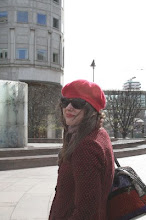The magic is already melting as if it were never there.
And the days have lately been filled with broken down trains; slippy, sliding cars; 'ice', mouths snapping out the word in disgust and trepidation; cold that gathers in cold, that seeps into the bones and never lets go. London has been a united wail of curses, of frustration, of people sighing and shaking their heads: "Will it never melt?"
But, at the beginning, when it all started and seemed new.
Everyone stomped through the powder with their mouths agape. They couldn't believe it. It had snowed! It had settled! And when it started to snow some more, they stopped what they were doing and lifted their eyes to the sky in bewilderment. People in offices turned from their keyboards and stared out of the windows for a minute or two, silently taking it in. People on buses put down their newspapers and gazed in wonder as this white, wintry carpet was unfurled on the world.
Back then, all you'd hear was "Beautiful"; "Magical"; "Pretty"; "Wow".
It's interesting to me that people can be united in their view - to some extent - of what's beautiful and what isn't. And they seemed to be in universal agreement that this was a thing of beauty. All the blogs I have been reading lately have also been about snow - Elspeth Thompson, the gardener and writer, wrote a particularly lovely piece. She too used the word 'beautiful'.
But why is it beautiful?
Is it because it casts an eerie glow that speaks to us of never-ending light?
Is it because it separates difference and renders everything the same? Things lose distinction and all is on level footing – oh, how we'd like society to operate along the same lines, although it never can and never will.
Is it because of the overwhelming white, the white that makes us shield our eyes and blink back awe? White isn't, after all, an absence of colour, but all the colours of light combined. Once again, snow amalgamates everything and assimilates it into something – a united thing that hides the details, the drudgery, the dirt.
No wonder white speaks to us (symbolically) of innocence, truth, purity and goodness. No wonder we have ‘black magic’ but would not have white; ‘ America calls the Presidential residence the 'white house', but would not call it black. White is the colour of clouds, of daylight, the foam of the sea. Black is the colour of night, of absence, of what floods our senses once we sense to be.
The snow is also beautiful because it is unusual. A rare occurrence. Perhaps Inuits call snow beautiful, but I don't know. Probably not. The everyday usually isn't. We come to expect it, demand it, and it loses its power - sometimes unfairly.
What the Inuits DO have is a far greater capacity to appreciate the function of snow. They use words like aput - 'snow on the ground'; gana - 'falling snow'; piqsirpoq - 'drifting snow'; and qimuqsuq - 'a snow drift'.
We just say 'snow'. We stumble around adjectives but that is all it is to us – snow.
Perhaps analysis corrupts our sense of beauty.
Perhaps snow is beautiful because we do not truly understand how it transforms the fast, invisible, dispersing, disappearing rain into this thing of substance that flutters down from the sky and cleaves to the ground. How it melts in our hands but stays steady beneath our feet.
How, for a little while, it makes the impermanent seem permanent.
Sunday, 17 January 2010
Subscribe to:
Post Comments (Atom)

No comments:
Post a Comment